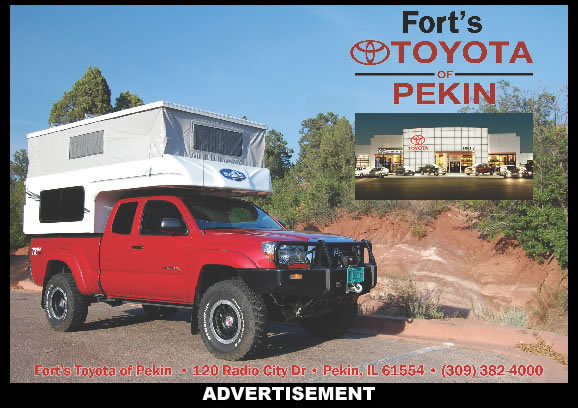Acquisition:
In the early months of 2007 my needs had morphed. My wife and I had brought home Jada, our now 100+ lb. German Shepherd traveling companion, and the Extra-Cab just wouldn't work for us --we needed something with 4 doors. Not only was I looking for a double-cab, but I wanted something a few years newer and 100% stock with much lower miles. Keep in mind this truck was intended to be comfortable on the road, including highways speeds and economy at full-load, as well as capable in a wide variety of off-road terrain. Basically I wanted to start over and recreate my previous truck, but on a low mileage 4 door chassis. At the time, the difference between the resale value of a low-mileage 1st-generation 4 door and the purchase price of the newer 2nd generation 4 door was nearly a wash. I had some experience modifying the newer 2nd generation Tacoma's, but there were a few things about them that kept me searching for the older albeit harder-to-find 1st generation Tacoma. I searched all the usual avenues (classifieds, internet, and dealer websites) and found myself going to look at dozens of different trucks. I found a couple of clean double cab lease returns at Tony Divino Toyota in Ogden, Utah, and decided I would take the hour drive up there for a closer look. While they had two trucks that fit my needs (I was picky, searching only for white, red or silver double-cabs, grey interior, etc), there was a truck being traded in while I was on the lot-- a red 2004 double cab. They hadn't even cleaned the truck, and it still had a smattering of the previous owner’s effects in the cab. I popped the hood and spotted the payday, a TRD super-charger. Eureka! The supercharger hadn't been a deal maker for me but it sure made the deal far more palatable. The price was right in line with the non-SC'd trucks they had on their lot and it had about the same miles I was searching for, under 50k. I did some background checking on the truck: a clean VIN and the SC had been dealer-installed when the truck was brand-new by a tech I happened to know, so I was confident with the install. The previous owner’s paperwork backed up the religious service the truck had seen making me feel even more comfortable with the purchase. The next day my wife and I trekked back up to the dealership to finalize the deal, and an hour later we were driving it home and it was mine. Time to start the build.
Initial Planning:
With the truck in hand I wanted to knock-out the bigger parts of the build as soon as possible. To streamline the process I collected all the parts on a shelf so that I could have it all ready to go. In one long weekend, we tackled the Old Man Emu suspension installation, front ARB winchbar, winch, lights, and the Safari Snorkel. Additional upgrades would take place over the next 2 years of ownership and in fact I guess I'm still adding little tidbits here and there, tailoring the truck to my needs as they arise.
Suspension/Axles
Basic Specifications:
OME 882 front coils w/10mm poly spacers & 10mm aluminum top-out spacers
OME Nitrocharger Sport Struts/Shocks
Dakar Springs w/AAL
Maxxis 32" Bighorns on steel wheels
OEM E-locker in rear axle
Energy Suspension Poly Rack & Swaybar Bushings
Notes: I had been thoroughly pleased with the Old Man Emu (OME) kit on my previous Tacoma, so when the time came to setup this suspension it was somewhat of a no-brainer. However, I did switch up a few things from my previous setup. As the front axle weight of this truck had greatly increased, I needed to bring up the front a bit. We experimented with about 5 different spring/coil/spacer combos until I found the current setup which has seemingly solved my woes. I've since installed similar setups on other 'heavy' front Tacoma's and 4Runners and found it to be a rather satisfactory setup. The rear axle weight was also much higher on this truck with the addition of the RTT and Bakkie Rack setup, weighing ~200 lbs of constant weight. To combat the added weight I added an additional OME leaf to the spring pack. Old Man Emu did not initially have an AAL application for this model but I had the luxury of having a pile of their different offerings in stock to play around with. I had actually been through this on a customer’s truck a few years earlier, so when it came time to bump up mine it was literally as easy as bolting the desired leaf in. In the last couple years I have been using a hitch-mount dirt-bike hauler to move around my 300 pound dirt-bike. The suspension squats a bit under its weight and leverage but really holds its own even when fully loaded for a trip, perfect! There are higher-performance (adjustable & remote reservoir) front suspension components available for the Tacoma, but for my needs the Old Man Emu components strike the perfect balance between performance and longevity, with an attractive price to boot. Many of the upgraded adjustable coil-overs don't fare well in Utah's harsh and salty winters or caustic desert environs. Having to rebuild a coil-over regularly or deal with a blown assembly in the middle of nowhere wouldn't work for me, thus cementing the OME option. It has rarely left me wanting and given my uses for this platform I would absolutely repeat that choice. (Update: OME now offers the OME D6XL additional leaf for the CS046R leaf springs. If I find my springs apart in the future I might swap them out with the AAL I've been using but this is far from a priority as it’s working fine as-is)
I've dabbled with a variety of different tires on my 4x4's over the years, but the last set of tires I put on my previous Tacoma had really proven themselves to me: the Maxxis Bighorns. While I don't feel they get the longevity of other similar mud-terrain offerings, they work well in various off-road conditions and have stalwart sidewalls. I've now had 4 sets of the Bighorns on my Tacomas and, knock on wood, I've never had a failure of the tire-- in fact I've had just a couple of leaks caused by sharp rocks or nails/screws. It’s far from conclusive but it’s won my repeat business.
As with any TRD-package Tacoma of this generation, the truck is equipped with the factory electronic rear locking 8" differential. This feature wasn't a deal breaker for me when purchasing the truck, as I'm a big fan of the non-locked 8.4" differential upgraded with an ARB Air Locker, but having the e-locker meant one less thing I had to install. Too boot, the Toyota e-locker is a fantastic design, and when needed is there at the push of a button.
Protection/Bumpers:
Basic Specifications:
- ARB Winchbar (XD9000) w/ End Cap Mod
- Custom Sliders welded direct to frame
- Bud-Built Skid Plate System
- All-Pro rear bumper (modified for towing abilities)
Notes: When I installed the ARB bumper and winch on my first Tacoma the end cap mod hadn't yet become the 'to-do' mod it is today. In fact, I had never even heard of a failure at that time. In several years of winch use the frame end caps did crack, one side completely separating from the frame. The fix was easy, but it was a hassle to remove the bumper. I also noticed less bumper vibration and flex following the end-cap modification. With this Tacoma the end cap mod was done right off the bat, and I consider it a mandatory modification for all bumper/winch installs on the 1st gen Tacoma, regardless of bumper brand or design. The added weight of the bumper, particularly those with winches, is just too much for the near sheet-metal cap on the factory frame. It adds approximately an hour to the install time and a welder is required, but it really is critical for any Tacomas that are going to see repeated winch use or a heavy bumper install.
While the rear bumper was the same basic All-Pro design that my last Tacoma sported, I opted to modify this one a bit for heavier towing capability. I moved the hitch receiver from the bottom of the bumper to the center line (horizontally), and added reinforcement straps from the back of the receiver to the Tacoma's frame. This mod does require the license plate to be removed while towing which is a bit of a pain but using a set of plastic screws and wing nuts I can have it on or off in a minute or two. I just toss the license plate in the rear window and call it good. If I towed enough I would look into an alternate mounting for the plate, possibly mounted in some fashion to the tailgate. I haven't used it to tow anything too extreme, but it has handled the dirt-bike carrier, my Trail-Trailer, and even an empty flatbed car-hauler trailer without any flex or tweaking.
The Bud-Built skid plates are stalwart, and do a great job protecting the vulnerable radiator, steering rack, and oil pans. My only complaints are that the oil drain hole is too small and the rest of the plates don't have any holes, so mud really cakes up on top and it’s near-impossible for it to drain out. It would get bad enough to create a mud 'cushion' between my t-case and skid plate, making a pronounced 'thud' when the mud dried up and the drivetrain flexed. I had them off for one of my steering rack replacements and decided to change that. I drilled a couple of dozen holes in the bottoms of the skids-- they are small enough that the effectiveness of the 'skids' are not diminished for my uses, yet large enough that most of the snow, mud, sand, etc drains out, and if not it is easily pressured washed out. It has worked wonders for keeping the caked-up mud out from under my truck, and I would recommend it to anyone with skid systems- Bud Built or otherwise- that see lots of miles down muddy roads.
In the next issue I’ll continue this build retrospective with details on how I solved Storage, Electrical, and Communications issues. Make sure you check it out in the June 2013 issue of Tacoma Magazine!
Kurt Williams has been a Land Cruiser owner since he was 15 and a Tacoma enthusiast for over 10 years. His strong love of 4x4s combined with business management skills has made Cruiser Outfitters a strong competitor in the four wheel drive retail industry.
Photos!
[flickr set=72157633191442377]
Remember, tell your friends! They can subscribe for FREE using this link!
.
{fcomment}











